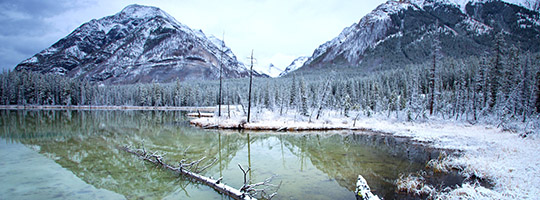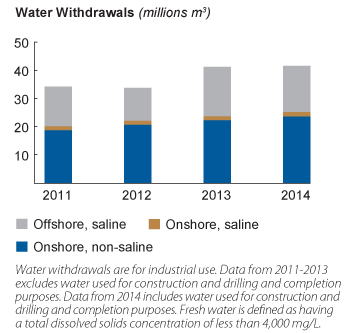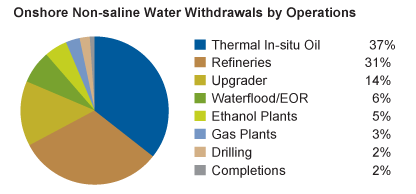Water

Purpose and Progress
Husky completes risk assessments to develop water management plans for operations. The Company enhances its responsible water use by employing technology and collaborative management strategies.
Water Withdrawals
Husky continues to improve its ability to track water metrics across all business units using the Environmental Performance Reporting System. It participates in a number of national and international programs that help drive better measurement and transparency of water use and issues across the industry.
The Company withdraws water for industrial use, drawing on saline and non-saline sources.


Onshore Non-saline Water Withdrawals by Operations
In 2014, non-saline water withdrawal increased slightly due to the startup of a new heavy oil thermal project in Saskatchewan, which is located in an area with relatively low surface water use. While non-saline water use increased, the volume of water required to produce a barrel of oil decreased for Husky’s Saskatchewan thermal projects.
Approximately 7.3 million cubic metres (m³) of non-saline water withdrawn for use in Husky’s refineries last year was offset by the 5.3 million m³ returned to the surface hydrologic cycle after being treated in multiple stages, including separating oil from the water and applying biological treatments. Before being discharged, the water is tested for regulatory compliance.
The withdrawal of 16.5 million m³ of offshore saline water in 2014 was partially offset by the discharge back to the sea of 10.7 million m³ of cooling water.
Non-saline Water Withdrawal by Watershed
In considering a water source for its operations, Husky evaluates risks, including reliability, sustainability, quality, technical feasibility, net environmental effect, economics and regulatory and stakeholder concerns. Where risks are identified, mitigation plans are developed.
Ways to conserve and recycle water are assessed, including consideration of reusing produced water in hydraulic fracturing operations.
In 2014, 97 percent of non-saline water withdrawals occurred in areas considered not water short or low intensity, as defined by provincial regulatory bodies. Two percent of the withdrawals occurred in areas considered potentially water short or moderate intensity and one percent of the withdrawals in areas considered water short or high intensity.
Approximately half of the Company’s onshore non-saline withdrawals were from the North Saskatchewan River watershed in Alberta and Saskatchewan and were used primarily in thermal production and upgrading operations. Water is withdrawn from along the river in areas that aren’t considered water short.
Approximately 30 percent of onshore non-saline withdrawals were from the Maumee River watershed in Ohio, for use at the Lima Refinery. More than 75 percent was returned to the surface hydrological cycle after being treated.
